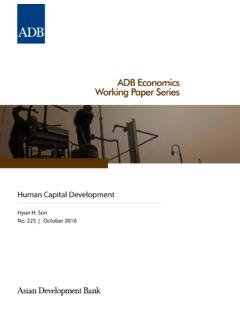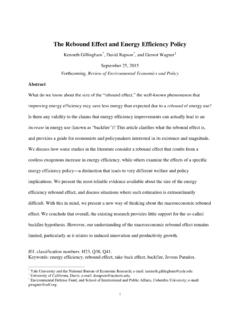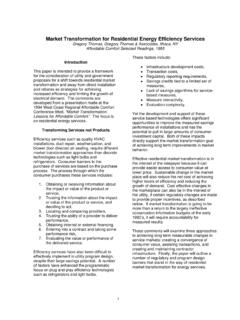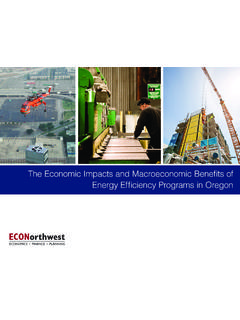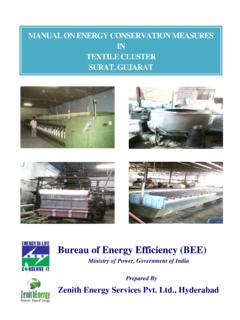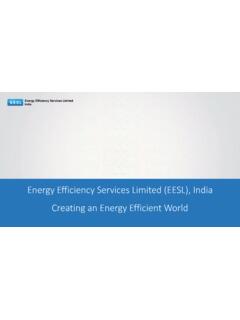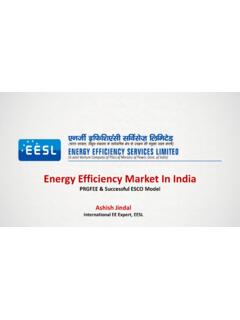Transcription of Proposed Loan Energy Efficiency Services Limited Demand ...
1 Report and Recommendation of the President to the Board of Directors Project Number: 48224-002 September 2016 Proposed loan Energy Efficiency Services Limited Demand -Side Energy Efficiency Sector Project (Guaranteed by India) Distribution of the attached document is restricted until it has been approved by the Board of Directors. Following such approval, ADB will disclose the document to the public in accordance with ADB's Public Communications Policy 2011. CURRENCY EQUIVALENTS (as of 19 August 2016) Currency unit Indian rupee/s (Re/Rs) = $ $ = = ABBREVIATIONS BEE Bureau of Energy Efficiency CO2 carbon dioxide EARF environmental assessment and review framework EESL Energy Efficiency Services Limited ESCO Energy service company GDP gross domestic product LED light-emitting diode MOP Ministry of Power NMEEE National Mission for Enhanced Energy Efficiency PAM project administration manual UN United Nations NOTES (i) The fiscal year (FY) of the Government of India and its agencies ends on 31 March.
2 FY before a calendar year denotes the year in which the fiscal year ends, , FY2016 ends on 31 March 2016. (ii) In this report, "$" refers to US dollars. Vice-President W. Zhang, Operations 1 Director General H. Kim, South Asia Department (SARD) Director A. Jude, Energy Division, SARD Team leader J. Acharya, Senior Energy Specialist, SARD Team members B. Dunn, Principal Environment Specialist, Sustainable Development and Climate Change Department (SDCC) K. Enomoto, Energy Specialist, SARD L. George, Energy Specialist, SARD Y. Jang, Social Development Specialist, SARD Karbar, Senior Project Officer ( Energy ), SARD C. Lapsansky, Communications Specialist, Department of External Relations Rekha, Principal Counsel, Office of General Counsel S. Shafiq, Financial Management Specialist, SARD H. Zhang, Finance Specialist ( Energy ), SARD Y. Zhou, Environment Specialist, SARD Peer reviewer Y.
3 Zhai, Senior Advisor, SDCC In preparing any country program or strategy, financing any project, or by making any designation of or reference to a particular territory or geographic area in this document, the Asian Development Bank does not intend to make any judgments as to the legal or other status of any territory or area. CONTENTS Page PROJECT AT A GLANCE I. THE PROPOSAL 1 II. THE PROJECT 1 A. Rationale 1 B. Impact and Outcome 4 C. Outputs 4 D. Investment and Financing Plans 5 E. Implementation Arrangements 6 III. DUE DILIGENCE 6 A. Technical 6 B. Economic and Financial 7 C. Governance 8 D. Poverty and Social 9 E. Safeguards 9 F. Risks and Mitigating Measures 10 IV. ASSURANCES 10 V. RECOMMENDATION 10 APPENDIXES 1. Design and Monitoring Framework 11 2. List of Linked Documents 13 Project Classification Information Status: CompletePROJECT AT A GLANCES ource: Asian Development BankThis document must only be generated in Date: 30-Aug-2016 15:55:07 DataProject Number: 48224-002 Project NameDepartment/DivisionSARD/SAENC ountryExecuting AgencyEnergy Efficiency Services LimitedBorrowerDemand-Side Energy Efficiency Sector ProjectIndiaEnergy Efficiency Services (s) ADB Financing ($ million)EnergyEnergy Efficiency and AgendaSubcomponentsClimate Change Information Inclusive economicgrowth (IEG)Pillar 1.
4 Economic opportunities, including jobs, created and expandedEnvironmentallysustainable growth (ESG)Eco-efficiencyGlobal and regional transboundary environmental concernsNatural resources conservationMitigation ($ million) reduction (tons per annum)3,000,000 Climate Change impact on the of ChangeComponentsGender Equity and MainstreamingGovernance and capacitydevelopment (GCD)Client relations, network, and partnership development to partnership driver of changeInstitutional developmentKnowledge solutions(KNS)Application and use of new knowledge solutions in key operational areasSome gender elements (SGE) TargetingLocation ImpactProject directly CategorizationEnvironment: C Involuntary Resettlement: C Indigenous Peoples: and SourcesAmount ($ million) Sovereign Sector loan : Ordinary capital Efficiency Services Development CooperationUse of country procurement systemsYesUse of country public financial management systemsYes I.
5 THE PROPOSAL 1. I submit for your approval the following report and recommendation on a Proposed loan to Energy Efficiency Services Limited (EESL), to be guaranteed by India, for the Demand -Side Energy Efficiency Sector 2. The project will finance high-priority areas under EESL s Demand -side Energy Efficiency operations under its Energy service company (ESCO) business This includes the (i) use of more efficient light-emitting diodes (LEDs) by municipalities for streetlights that could be operated remotely; (ii) use of more efficient LED bulbs, tube lights, and electric fans by households and institutions; and (iii) promotion of more Energy -efficient agricultural water II. THE PROJECT A. Rationale 3. Energy Efficiency approaches are the most cost competitive of the technology options to provide better quality Energy Services .
6 Upward projections for global economic growth by the World Bank4 and the emerging role of developing countries as a hub for industrial activities will increase Energy Demand , and awareness of the need for greater Efficiency in Energy use is growing worldwide even more so in developing countries. According to the International Energy Agency, developing Asia s share of worldwide Energy -related carbon dioxide (CO2) emissions more than doubled from 17% in 1990 to 39% in 2013. Without additional efforts to decarbonize, developing Asia is expected to account for 46% of CO2 emissions by These projections reflect Asia s increasing role as a center of manufacturing and home to over half of all global megacities, further exacerbating Energy security and environmental constraints. A stronger emphasis on Energy Efficiency , both from the Demand and supply side, is required, as well as accelerated investments in renewable Energy and in the deployment of advanced low-carbon technologies to reduce local air pollution that causes damage to health and the environment.
7 Given that India is already one of the world s largest and fastest-growing economies, low-carbon growth in India will have a great impact on the overall global situation. 4. India s economy has grown rapidly, with an average annual gross domestic product (GDP) growth rate of since 2000, compared with an annual global GDP growth rate of in the same period. High economic growth is underpinned by increased Energy use. The government is ramping up its efforts to provide reliable electricity to close to 300 million people. As a result, the total primary Energy supply almost doubled from million tons of oil equivalent in 2000 to million tons of oil equivalent in 2013. Annual CO2 emissions from fuel combustion have grown even faster, from million tons in 2000 to 1, million tons in 2013, as the fuel mix in India is largely based on fossil The potential for further economic growth and rapid increase in Energy Demand in India is enormous.
8 1 The design and monitoring framework is in Appendix 1. 2 ESCOs generally develop, design, build, and fund projects that save Energy and recover their investment from their customers over time based on Energy cost savings. (Refer to Supplementary Linked Document 14). 3 The Asian Development Bank (ADB) provided project preparatory technical assistance for Preparing the Demand -Side Energy Efficiency Investment Project (TA 9081-IND) and will continue to provide technical support during project implementation. 4 World Bank. 2016. Global Economic Prospects: Divergences and Risks. Washington, DC. 5 International Energy Agency. World Energy Outlook 2015. 6 International Energy Agency. Statistics. 2 5. Sector challenges. Key changes in policy priorities and investment strategies will be necessary particularly in India, where rapid economic growth is coinciding with urbanization impacts.
9 Among the barriers to India realizing its full Energy Efficiency potential are (i) regulatory challenges, as electricity is subsidized to some extent and Energy Efficiency programs are voluntary; (ii) institutional challenges, as capacity to support the scaling up of Energy Efficiency is Limited ; (iii) financing challenges, as some Energy -efficient technologies have high up-front costs, but project sizes are small from a lender s perspective, and returns may be difficult to quantify; and (iv) Limited understanding of Energy -efficient technologies and associated benefits limits its uptake. Delivering Energy Efficiency through third-party financing following an ESCO delivery mechanism can help in scaling up the implementation of Energy Efficiency projects. However, ESCOs require support in accessing commercial finance and managing technical performance and payment security risks.
10 Long project development lead times and high transaction costs also affect their viability; thus, there is a need to support the demonstration of a viable company that can contribute to transforming the market through various Energy -efficient technologies using the ESCO business model, which can then be scaled up and replicated. 6. Alignment with government priorities. Against regional trends for growth and in recognition of Energy Efficiency benefits, large emerging economies, including India, have launched initiatives resulting in significant Energy Efficiency improvements. The government has determined that increased end-use Energy Efficiency is critical for meeting India s rapid Energy Demand growth. In 2015, the government pledged to reduce the emissions intensity of its GDP by at least 33% below 2005 levels by 2030 as part of its intended nationally determined contributions to the United Nations (UN) Framework Convention on Climate A recent Asian Development Bank (ADB) report suggested that achieving an intermediate target reduction of at least 20% in emissions intensity by 2020 would require investing approximately $68 billion in Energy Efficiency measures in Investments in Energy Efficiency are increasingly being recognized by the government as the most cost-effective option (in the short to medium term) to reduce Energy costs, deliver increased economic productivity and competitiveness, increase Energy security, and combat climate change.









